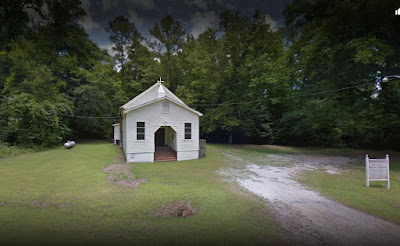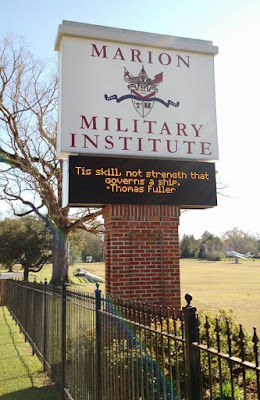An Alabama folk artist will know he’s made it when his work graces the walls of a Manhattan apartment, even if he doesn’t see much cash from the sale.
 |
| An outdoor folk art installation in the woods. |
The Confederate Cemetery at Marion is full of Union soldiers who died in hospital here. They outnumber their southern brethren, in fact, with whom they’re buried side-by-side. It was just one of many surprises here in Perry County. This is the second-poorest county in Alabama, which is itself the 47th poorest state in America, but it’s also a proud and beautiful place.
“There’s art in these woods,” our guide, Pastor John Nicholson of Siloam Baptist Church, told us. Sure enough, tacked to the trees were paintings on pieces of old tin roofs. “There used to be lots more,” John lamented. I hope that a gallerist doesn’t discover this open-air gallery any time soon. Then, instead of being free to the citizens of Marion, the art will cost $20 for Manhattanites.
 |
| Cypress swamp in Perry County, Alabama. |
In the bigger world, money conveys legitimacy. Earnest Williams isn’t making any money by tacking his paintings onto trees. When his paintings sell for six figures and grace the walls of an Upper East Side
classic six, he’ll know he’s arrived, although he will probably see very little actual cash from it.
The UN instructs us that Alabama is
practically a third-world nation. My husband was in Haiti a few years ago. “Does that look like Haiti?” I asked him as we passed a particularly ramshackle cabin.
“Perhaps like the very best house in Port-au-Prince,” he answered.
 |
| Antebellum house in Marion, Alabama. |
I do know the slums of Rochester pretty well, and measure for measure, I’d rather be in the woods. New York
ranks 15thin America for wealth but
right behind the District of Columbia for income inequality. I’ve known plenty of people living in a different kind of squalor. If your neighbor is a snapping turtle or black bear, you’re already wealthier than the family living next to a drug house with a chronic rat problem.
There is a lovely antebellum house mouldering on Marion’s main street. This is not because of poverty, but because of family dynamics; the owners are alive and prospering just around the corner.
 |
| Old slave housing in Marion, Alabama. |
A sermon or seven could be preached about this house’s fall from grace. Camellias of every variety bloom in its overgrown lawns. Its slave quarters stand as they did in the 19th century, as does its outdoor kitchen. For the first time in years, I’m motivated to paint something overtly instructive. I took many, many photographs. “You’ll just have to come back,” John said.
South of town, the landscape is less woodsy and more prairie. We stopped by a lovely old farmhouse in the middle of pasturage, lakes and ponds. It would be the perfect place for a workshop. I’m seriously thinking about it.
 |
| Camellias in bloom. |
I stopped in Montgomery for lunch. This is more like the New South I’ve read about, a 20th century boom-town, with bustling restaurants and souvenirs in its riverfront area. A tour guide cheerfully herded her charges down pavements that once served as Montgomery’s slave market.
There’s a small industry here in Hank Williams remembrances, with people picking over the details of another poor Alabama boy’s life. I’m a fan, so we dutifully forked over our $20. A swank tour coach from Georgia was parked next to his grave.
Next stop, Mobile.





